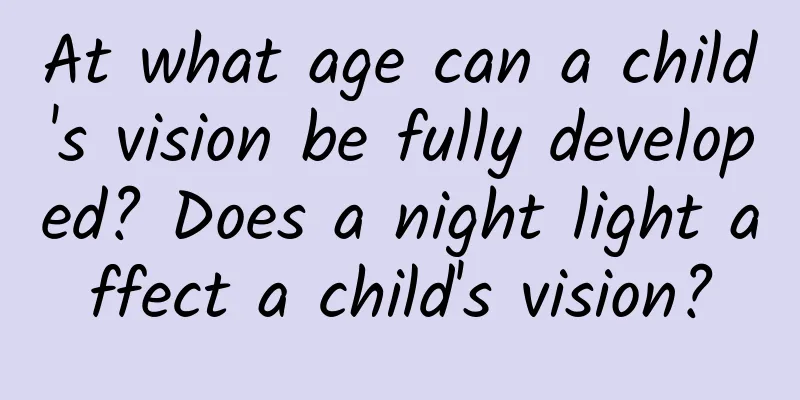At what age can a child's vision be fully developed? Does a night light affect a child's vision?

|
Author: Yu Gang, former chief physician of Beijing Children's Hospital Reviewer: Tian Bei, Chief Physician, Beijing Tongren Hospital, Capital Medical University When a baby is born, his vision is only about 0.02. As the baby grows up, his vision will get better and better. If the baby has various eye diseases after birth, such as cataracts, myopia, astigmatism, or hyperopia, it will affect the development of vision. Therefore, after the baby is born, it is important to observe factors that affect vision and go to the hospital regularly for vision screening. Only with a good visual environment and careful care can the baby's vision develop healthily. 1. Under normal circumstances, at what age after birth will a child’s vision mature? What should be the normal vision for children of different ages? There is a particularly simple method: for children under 6 years old, multiply their age by 0.2, which is the baby's normal vision. For example, a 3-year-old child’s vision should be 0.6; a 4-year-old child’s vision should be 0.8; and a 5-year-old child’s vision should be 1.0. Some children’s vision stops developing after reaching 1.0. Is this normal? Everyone's vision development environment and genetic factors are different. For some children, for example, their vision develops to 1.5 or 2.0, which is better, but there is no problem with 1.0. The most basic vision development standard is 1.0. 2. How often should a child have an eye examination after birth? Normal children can go to the hospital for a vision screening when they are six months to one year old. The vision can be checked using an electronic automatic ophthalmometer, and the child’s cooperation is not required. There is a disease called retinopathy of prematurity. When a baby is born prematurely, the weight is not enough and he needs to breathe oxygen to save his life, which can lead to retinopathy. This condition needs to be checked about every two months. If the physical examination finds that the baby has pathological myopia, early intervention is necessary. Many children are about to enter primary school when a physical examination suddenly finds that one eye is 700 degrees myopic. At the age of 7, the vision has basically stopped developing, and there is almost no chance of treatment, so early detection and early intervention are necessary. Many congenital eye diseases in children are inherited. For example, if the father has glaucoma, the grandmother has strabismus, or the great-grandmother has cataracts, etc., you must take your baby for an early check-up. Figure 1 Original copyright image, no permission to reprint In clinical practice, we have encountered a case where a grandfather had small palpebral fissures, and his two daughters both had small palpebral fissures. One of the two daughters gave birth to a boy and the other gave birth to a girl, and both had small palpebral fissures, so genetic factors cannot be ignored. 3. Is it normal for a child to be farsighted when he is born? Children are born with a certain degree of hyperopia, which we call hyperopia reserve, or in layman's terms, the bank deposit of children's vision. Hyperopia reserve is an indicator to measure whether a child will develop myopia prematurely. When a child's hyperopia reserve drops from 200 degrees to 150 degrees and then to 100 degrees, myopia will begin to develop as the child's hyperopia reserve decreases. Figure 2 Original copyright image, no permission to reprint So, is it true that the larger the hyperopia reserve, the better? Not really. It is normal for a child to have 300-400 degrees of hyperopia at birth. The hyperopia reserve should not be too large or too small. If it is too small, it will lead to premature myopia. If it is too large, it is not good either. For example, if a child has 700 or 800 degrees of hyperopia after birth, it will cause a disease called amblyopia. If a child has 300 degrees of hyperopia reserve when he is in primary school, he can watch TV, use computer and play with mobile phone appropriately without any problem. If he has only 50 degrees of hyperopia reserve when he is in primary school, then he should try to reduce the use of all electronic products. If he has neither myopia nor hyperopia when he is in primary school, that is, his hyperopia reserve is zero, this indicates that the child may soon become myopic. Therefore, after the child is born, we must protect its eyes well, allow it to develop healthily, and reduce factors in life that are not good for the baby's eyes. 4. Do bathroom heater lights and night lights harm children’s eyesight? After measuring the illumination of the bathroom heater, we found that it still has some harm to children's eyesight. Try not to let children look directly at the bathroom heater when taking a bath. Night lights are also harmful to children, but not because of exposure. A US scholar conducted a study to observe the vision development of children who slept in a dark environment, children who slept with a headlight on all night, and children who slept with a night light on. After 5 years of examination, the incidence of myopia in these three groups of children was about 35% in the group that turned on the night light, 42% in the group that turned on the headlight all night, and only a few percent of those who slept in a dark environment at night. There are two side effects of turning on the night light. The first is that it can cause myopia in children, and the second is that it can disrupt the biological clock of children. When the night light is on, the baby does not know whether it is night or day. Some parents say that their children cry every night and sleep during the day, which is because the biological clock is disrupted and day and night are reversed. Figure 3 Original copyright image, no permission to reprint Night lights can be used, but they must not be turned on continuously. In addition, the night light can be placed lower, preferably below the child's line of sight, and the light is also softer, then there will be no problem. Keeping the lights on all night does not do any good for children. Parents must pay attention that it is best to let children sleep in a dark environment. |
<<: Do you know what the “three axes” for preventing and controlling myopia in children are?
>>: If a child has a lump on his eye, it may be a chalazion and should be treated promptly!
Recommend
What are the benefits of having a colposcopy?
The vagina is an important female reproductive or...
Can I fly when I am one month pregnant?
Nowadays, people choose to travel by plane, which...
Pregnant woman with yellow urine will give birth to a boy or a girl
The color of a pregnant woman's urine can det...
How to avoid miscarriage when pregnant
During pregnancy, a woman's body is more sens...
How many days does my period usually last?
"Aunt Flo" is an image-based name for w...
Why do I have plaques in my carotid artery even though I don’t have the three highs? Should I take statins?
A friend told Huazi that he was diagnosed with ca...
Physical characteristics of difficulty in conceiving
What are the characteristics of women's physi...
What medicine is most effective for inducing menstruation?
Menstruation is a normal physiological phenomenon...
When should I start using essence? How should I use essence correctly?
Women in their 25s often have dull complexions an...
What kind of household bathroom heater is good? Which one is more practical?
We all know that bathroom heaters are a very comm...
Successful pregnancy cases after taking clomiphene
Many couples who are preparing for pregnancy are ...
What does mild hemolysis mean?
Mild hemolysis generally means that internal or e...
Can’t wear a turtleneck, is it because I’m being pretentious or a disease?
Seasonal cooling season There are always people w...
What are the movements of the fetus at five months?
At five months of pregnancy, fetal movement alrea...
What is the problem with the fishy smell of vaginal discharge?
It is a common phenomenon that leucorrhea has a f...









